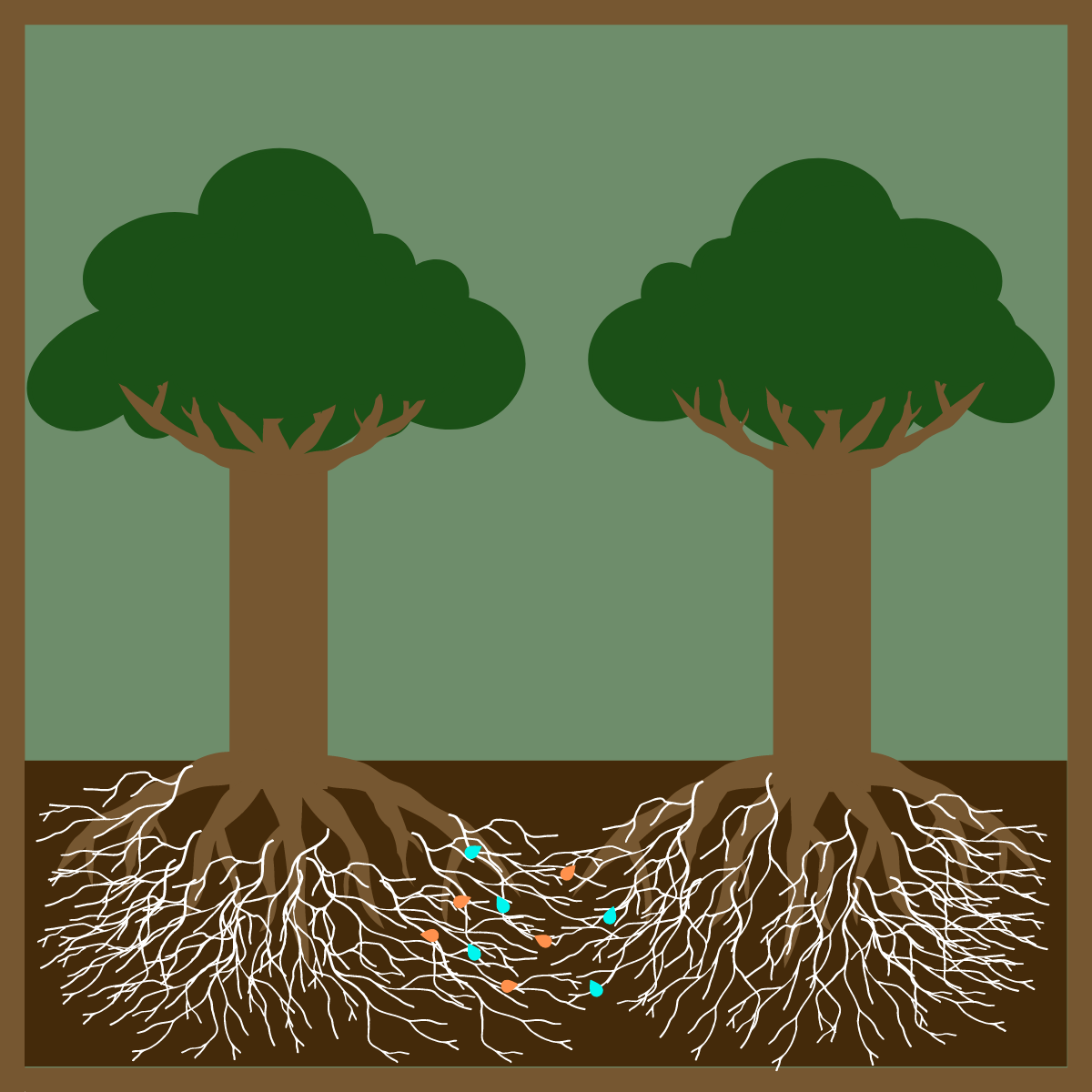FOREST LEARNING HOME
An Introduction to Soil
When people walk through a forest, most focus on the trees, the plants, and the wildlife they see around them. What many fail to notice, however, is the ground beneath their feet. The soil in a forest is just as important—if not more so—than the life visible above the ground. But why is that?
Two words: Fungi and carbon.
A Background on Fungi
Fungi belong to their own kingdom. They aren’t plants or animals, but loosely share some traits with both. Fungi are everywhere—not only in forests, but all around us. In fact, with every inhale, as many as ten fungal spores enter your body.[1]
In a forest, some fungi are visible because they grow partially above the ground. These growths are mushrooms. Mushrooms are incredibly diverse, both in their appearance and in their other traits. Some are delicious to eat, others have psychedelic properties, and others can kill you.[1] However, the true wonder of fungi lies not in their mushrooms, but under the surface of the soil. Fungi have thread-like mycelia connecting them to the roots of the surrounding plants and trees.[1] In forests, mycelia are so dense that according to Merlin Sheldrake, author of the 2020 book Entangled Life, one teaspoon of soil could contain enough threads to stretch ten kilometers.[2]
All Photos Courtesy of Ashish Gupta
Graphic Courtesy of Tracy Wilkinson

Unlike their mushrooms, which can’t move, a fungus’s mycelia can “explore” the world, and even have a basic form of memory, allowing them to remember where they’ve found food in the past.[2] The mycelia create a sort of “trade route” as the fungi swap carbon for the nutrients they take from the soil. The trade routes form a fungal network between the trees in an area, allowing them to “communicate” through their traded nutrients, carbon, water, hormones, defense signals, and more.[3] Research shows that plants connected to fungal networks can send chemicals across larger distances than plants without a network.[2]
Older, more well-connected, trees are called mother trees. The mother trees can recognize their own children and choose to share more with them than they do other seedlings, just as human parents usually take care of their own children more than a stranger’s. When a mother tree is in trouble, it can send information to its seedlings through the fungal network to increase the children’s chance of survival.[3] In short, forests are more than just a stand, or a group of trees. Forests are networks of life able to share, nurture, and communicate.
Carbon Storage in Soil
There are two main types of fungal networks, and both increase a plant’s carbon dioxide intake. The first type, ectomycorrhizae (EM for short), shape themselves around root tips to form sock-like structures. The other, arbuscular mycorrhizae, (also known as AM) grow in the roots of plants.[2] EM networks help a plant take in carbon dioxide more efficiently, but they also prefer colder climates. As the climate continues to change, AM networks, which thrive in warmer climates, become more common in previously EM-heavy ecosystems, decreasing the carbon intake of the forest.[2]
As the carbon is moved and traded throughout fungal networks, some of it is stored within the soil.[4] Fungal networks also gain connections and store more carbon over time, so when humans cut down old-growth forests, huge amounts of carbon are released from the soil. Even when loggers plant new trees to regrow the forests, the net carbon storage of the forest decreases.[5] Carbon storage in forests is essential to slowing climate change because it reduces the greenhouse gases (GHGs) in the atmosphere. Despite what some people think, thinning forests does not increase the stored biomass because it takes time for carbon to build up. Therefore, thinning contributes to emissions.[6]
[1] Fantastic Fungi. Directed by Louis Schwartzberg, Moving Art, 2019. Netflix app.
[2] Hulick, Kathryn. "Secret forest fungi partner with plants — and help the climate." ScienceNewsExplores, 9 Dec. 2021, www.snexplores.org/article/secret-forest-fungi-partner-with-plants-and-help-the-climate.
[3] Simard, Suzanne. "How trees talk to each other." TEDSummit, Technology Entertainment Design. TED, www.ted.com/talks/suzanne_simard_how_trees_talk_to_each_other.
[4] Maloof, Joan. "Why Old-Growth Forests are Essential for Slowing Climate Change." Oregon Chapter Sierra Club. Zoom, sierraclub.zoom.us/rec/play/T7tktSNS4Rw8v_bp6sDbqZJPrqNGnRw6RcmlYaxinYiG5hksrzDz0oBYEu75FVI-5UnJn96Ze6ydPlH9.9DcgChwjk8t6RCgt?startTime=1644544950000&_x_zm_rtaid=naaRD_DhRh2-CsXjcvDvcg.1652826133160.f6ade80a1ebe5a779f66b76f9d71db31&_x_zm_rhtaid=105.
[5] Maloof, J., and V. Goold. "Recent findings on carbon storage in old-growth forests." OldGrowthForest, Old-Growth Forest Network, 2020, static1.squarespace.com/static/5c087e9e4cde7a66033e482d/t/5f5908ed8ea49e78c62fcb57/1599670514807/Wild+Carbon+and+Wild+Forests.pdf.
[6] Law, Beverly, et al. "The Status of Science on Forest Carbon Management to Mitigate Climate Change (June 1, 2020)." OlyClimate, 1 June 2020.
Learn More!
Logging Biodiversity Climate Change Carbon Storage Solutions & News Connections